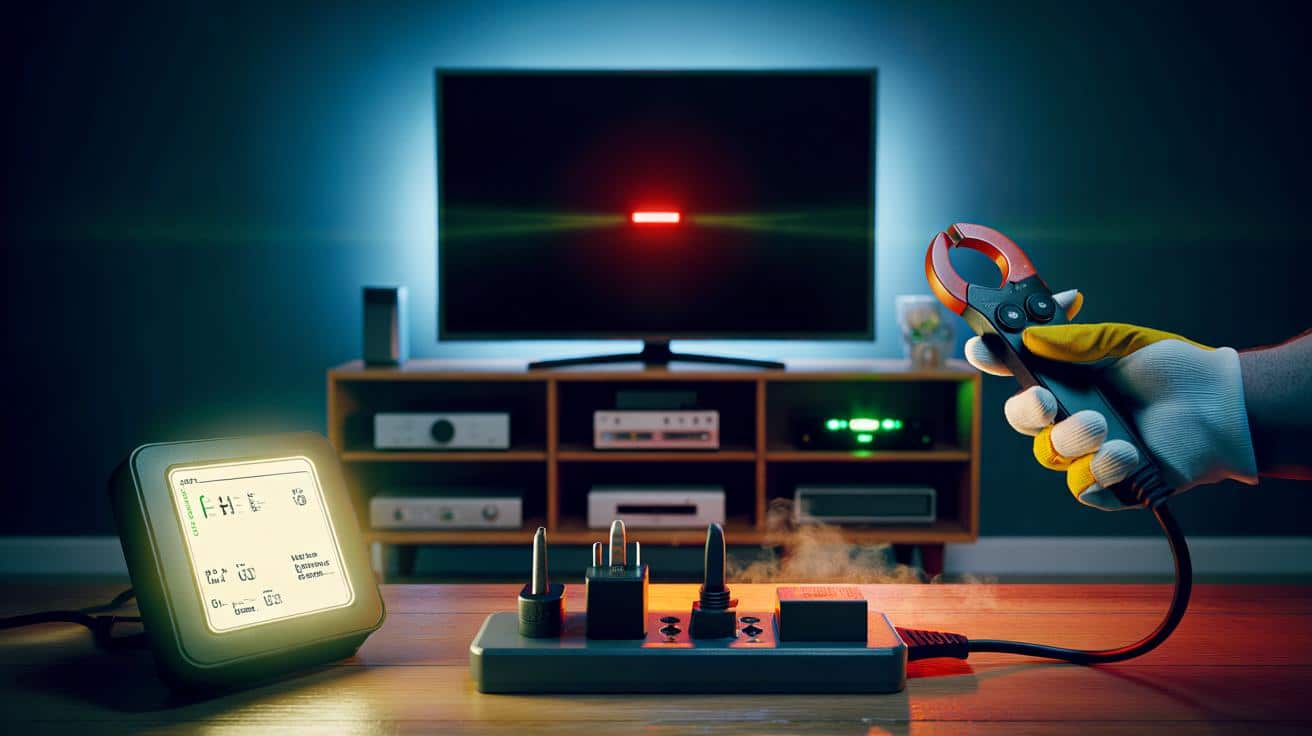Small lights glow, plastic feels warm, and pennies slip away unnoticed.
Electricians have a simple, almost playful routine that turns your living room into a crime scene for wasted watts. It starts with numbers on a meter and ends with a handful of easy wins that shrink your always-on baseline without denting your comfort.
What keeps sipping when ‘off’
Standby rarely means zero. A red LED on the TV, a microwave clock, a warm plug-top charger, and a humming router all keep drawing power so they can wake quickly, keep time, or stay connected. Each sip looks tiny. Over a year, the trickle becomes a stream.
Between 5% and 10% of a typical household’s electricity can vanish in standby each year, without adding comfort.
Families who test this often get a shock from their smart meter. Switch everything “off”, then watch the figure barely budge. The culprits are familiar: set‑top boxes, games consoles in quick start, printers left network‑ready, soundbars on standby, and internet boxes that never truly sleep. Routers and mesh boosters run 24/7 unless you schedule them.
Why that sip never stops
Modern electronics keep power supplies energised, network chips listening, and memory alive for instant start‑up. A console that launches in seconds may sit at 8–12 W when you think it’s idle. A streaming box drifts around 5–7 W waiting for updates. Even a tiny 0.3 W charger adds up if you leave several in a live extension lead.
The electricians’ three-step test
The method fits on a sticky note: measure, isolate, confirm. No lab gear, no fuss.
1) Measure the night baseline
Pick a quiet hour. Check the smart meter display or in‑home monitor for live power. Note the number. If lights and appliances are “off” and the figure still sits high, you’ve got an always‑on load to tame.
2) Isolate by circuit
At the consumer unit, switch off one breaker at a time and watch the live reading. Wait a few minutes between changes because fridges and hot‑water cylinders cycle. When the number drops, you’ve found the suspect circuit. Switch back on, then repeat to narrow it further.
3) Confirm at the plug
Use a plug‑in power meter to test individual devices on that circuit. Leave each device connected for at least a minute to capture true idle draw and background updates. For fused spurs or hard‑wired kit, a clamp meter around the live conductor helps gauge draw without dismantling anything.
If the live power won’t fall close to zero with everything “off”, a hidden vampire still sits on that circuit.
Tell‑tale signs you can feel
- Warm plug‑top or power brick: power supply energised even when idle.
- Breathing LEDs or status lights: background processes and network checks.
- Clocks and USB ports that stay live: constant trickle by design.
- Quick‑start or instant‑on settings: faster wake equals higher standby.
Numbers you can use
A small wattage 24/7 becomes a big annual cost. Use this to estimate it yourself:
Annual cost (£) = standby watts × 8,760 ÷ 1,000 × unit price (for example, £0.28 per kWh)
Examples at £0.28/kWh: 6 W equals 52.6 kWh a year, about £14.75. Ten watts comes to 87.6 kWh, around £24.53. Trim just 35 W from your always‑on baseline and you keep roughly £86 a year in your pocket.
Drop your always‑on baseline by 35 W and you save about £86 each year at 28p per kWh.
Simple fixes that stick
Focus on easy changes that you’ll keep using. You don’t need to unplug the fridge or fight your alarm system. Go for the high‑yield clusters.
- TV corner: put the TV, set‑top box, streaming stick and soundbar on a switched extension lead. One flick cuts the lot when you head to bed.
- Games consoles: disable instant‑on or fast start. Use full shutdown overnight. Schedule updates for daytime.
- Home office: printer, monitor and speakers on a master switch or smart plug. Laptops charge on a timed window rather than all night.
- Networking: if everyone sleeps, schedule Wi‑Fi off from midnight to 6 a.m., or use the router’s eco mode. Keep phone data as a backup for emergencies.
- Small kitchen kit: microwave, coffee machine and blender on a switched bar. The clock on the oven can stay; the microwave clock doesn’t have to.
- Chargers: group them on one switched bar so they’re not live all week.
What to tackle first
Start where the kilowatts hide. The TV stack, the console, and the router usually beat everything else. Printers left “ready” can burn 3–8 W; they add cost with no benefit outside working hours. A single streaming box idling at 7 W costs about £17 each year; multiply that across rooms and your baseline swells fast.
Typical standby culprits and annual costs
| Device | Typical standby (W) | Yearly cost at £0.28/kWh | Quick fix |
|---|---|---|---|
| Wi‑Fi router or mesh node | 8 | £19.60 | Schedule night‑time off or use eco mode |
| TV with quick start | 5 | £12.26 | Disable quick start; use full shutdown |
| Games console instant‑on | 10 | £24.53 | Turn off instant‑on; schedule updates |
| Streaming box/set‑top box | 7 | £17.17 | Switch at the wall overnight |
| Printer “ready” mode | 4 | £9.81 | Power down after use; smart plug timer |
| Microwave clock | 2 | £4.91 | Switch at the wall when not needed |
| Soundbar standby | 3 | £7.36 | Group on a switched bar |
| Idle phone charger | 0.3 | £0.74 | Unplug or switch off at the bar |
Avoid these traps
- Cold appliances: don’t switch off fridges and freezers. They cycle by design, and restarting wastes more energy and risks food safety.
- Hot water: immersion heaters and cylinders can wake on timers; changes take time to show at the meter. Wait between tests.
- Security kit: keep alarms, cameras and smoke alarms powered. Move the rest to switched circuits around them.
- Overloading: use certified surge‑protected extensions and keep total loads within their rating. Heat on a plug or lead means stop and rethink.
Standby rules and when upgrades pay
Many modern devices meet strict standby limits around 0.5–1 W for basic modes, yet networked standby can sit at 2–8 W. Older kit often fares worse. If your baseline stays high after good habits, consider replacing the worst offenders first: a 2012 set‑top box or an ageing router can cost more to run each year than a new, efficient model. Look for low standby figures on the spec sheet and energy‑saving scheduling in the settings.
Try a quick simulation. If your always‑on baseline is 60 W, that’s 525.6 kWh a year. At 28p per kWh, you spend about £147 just to keep the lights off. Cut that baseline to 25 W and the annual cost drops to about £61. The difference buys a decent smart strip and a plug‑in power meter, with money left over.
Turn data into a routine
Give yourself a weekly two‑minute check: glance at the live smart meter read before bed on Sunday. If the number creeps up, hunt the new culprit with the three‑step test. Add labels to switched bars so family members know what can go off. Set quiet‑hour schedules once and forget them.
For rentals or shared homes, a simple rule works: “red light, switch at night.” Anything that glows without purpose joins the switched group. Keep safety systems and cold storage separate. Small, steady gains beat complicated plans, and the meter will prove it every month.








